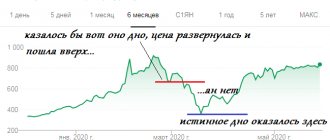An IPO is essentially the following procedure:
A certain company, organization or issuer, in general, issues securities on various stock exchanges. So in Russia, organizations implementing IPOs are called joint-stock companies. Whereas in the West, companies with exactly the same actions regarding the release of their shares into circulation on financial markets are called “public companies”.
When companies and organizations carry out the IPO process, it is understood that after completing such procedures, shares of these issuing companies can be purchased on stock trading platforms by anyone. And to purchase securities of these issuers, as you know, it is enough to have your own trading account with a brokerage company.
Of course, have a brokerage account with a broker that provides access to the stock exchange. So, in Russia, shares or other securities of issuing companies can be purchased on the Moscow Interbank Currency Exchange (MICEX). It is noteworthy that in Russia, the first public offering of shares also includes secondary offerings of securities. And also, additional issues of papers for the life of their organizations!
https://www.youtube.com/watch?v=i90bi4YqEWc Video on the topic of IPO.
The essence of an IPO.
If we try to summarize the whole essence of an initial public offering, it turns out that the IPO process is nothing more than an organization’s entry into the stock market. That is, this means that the issuer issues shares for general trading. Subsequently, these papers can be purchased by anyone.
Securities placed on the largest trading and financial platforms. And as mentioned above, domestic companies, most often, issue securities of their organizations on the Moscow Stock Exchange.
Whereas Western companies place shares of their companies on Western stock exchanges - accordingly! Western stock exchanges include NASDAQ (High-Tech Exchange), NYSE (New York Stock Exchange) and CHX (Chicago Stock Exchange).
It is noteworthy that both Russian companies and their Western “colleague competitors” can carry out the IPO procedure on trading platforms in countries other than their own. That is, just as Russian joint-stock companies can issue their securities for circulation on Western markets, so overseas holdings can conduct public offerings of shares of their enterprises on Russian trade and financial exchanges.
The largest IPOs in Russia
In Russia, the leader in terms of the volume of funds raised during an IPO is still Rosneft, which managed to attract $10.7 billion in 2006. In second place is Sberbank - in 2007 it sold shares worth 8.8 billion rubles. In third place is VTB with its “people’s” IPO - during the campaign the bank increased its capital by $7.98 billion.
And here’s another interesting article: Review of the Moscow Exchange innovation and investment market: is it worth taking shares of high-tech companies
Russian shares are also placed abroad. The largest in terms of volume was the placement of Rusal shares on the Hong Kong Stock Exchange in 2010 - the company received $2.24 billion by selling a little more than 10% of its shares.
Ours are also on Nasdaq. For example, Yandex earned $1.3 billion from its placement. After which the company became known on the international market.
IPO of depositary receipts
Issuing companies can carry out the procedure of public placement of both shares and depositary receipts. Almost every self-respecting investor knows what stocks are. But not a wide range of financial figures know what a depositary receipt is. Therefore, let's take a brief look at this term.
In simple terms, a depositary receipt is a kind of record confirming that certain securities are stored in a bank . That is, shares of certain companies are held by the custodian bank. But at the same time, their owner has a receipt.
Practice shows that a depositary receipt and a share are equivalent securities. However, a depository receipt is easier to purchase for individuals (and not only) from different countries. Unlike shares, when purchasing them, some difficulties are often possible. And these “difficulties” are connected, for the most part, due to higher commissions or legislative restrictions on the activities of foreign brokers. But still, in most cases, an IPO is carried out in the form of a public offering, namely shares!
What is allocation
Allocation is the share of the amount of your application that the broker allocates to you, returning the rest to the account. IPO organizers are interested, first of all, in large sums from which they can make good money with the lowest transaction costs. Retail investors are not that interesting to them; at best, they are an additional resource for mass PR for the upcoming IPO (Road Show). Therefore, large institutional investors - banks, funds, investment companies - have a much greater chance of having their application satisfied.
I also recommend reading:
What does the P/B multiple say about the company's value?
P/B multiple is another way to look for undervalued companies
There may be three options for distribution. You will see the result in your personal account on the broker’s website:
- Your request is fully satisfied. It’s unlikely, and there’s no point in being particularly happy about this outcome. This means low demand from large institutional investors.
- The application is partially granted - the most likely scenario. The market average allocation level is about 30%;
- Your application was rejected: either you did something wrong, or there were some restrictions in place when distributing applications.
Reasons for IPO.
The main reasons for conducting an IPO, of course, include criteria such as attracting additional capital. It is also an alternative to bank loans, bonds and lending. So, for the use of “third-party” investments, of course, you have to pay through dividend payments. But in this case, the issuer itself regulates the amount of dividend payments on shares.
Yes, and otherwise, he may even temporarily “freeze” dividend payments. Quite even, at the legislative level. Of course, subject to a truly “difficult” economic situation in their economic affairs!
Among other things, an IPO is an absolute increase in the prestige of the enterprise itself. After all, if we look at this process from the point of view of an ordinary person, it becomes clear that the company was closed, but now it is public, it has become “well known” to everyone, and fame has come to it! Further, it is much easier for this company to attract additional clients. Investors who, in aggregate, will finance the enterprise well.
An IPO carried out by a company, having gone through the entire necessary “listing” path, indicates that the company has begun to fully participate in market relations. And as a result, the company gets the opportunity to influence its further capitalization. That is, to maintain the value of shares through a buyback, or by paying large dividends to their “philanthropic investors”!
Disadvantages of an IPO for the issuer
But you need to take into account the disadvantages and costs of going public. Every action has its consequences. So, the disadvantages of an IPO are:
- increasing control over the company - since it is forced to report publicly, it will be controlled by auditors, the tax service and supervisory authorities;
- increase in expenses - now you need to monitor shares, make payments (dividends), keep records, etc.;
- you need to disclose financial information - competitors can take advantage of it and get ahead in some respects;
- shares are diluted - hundreds and thousands of legal entities and individuals become the owners of the company;
- you will have to reckon with large shareholders - funds or private investors can methodically buy up shares in order to be able to influence the company or even gain partial control over it;
- Most likely, you will have to share profits with shareholders - or explain to them why there will be no dividends and make sure that stock prices rise.
In addition, the IPO itself is expensive - thus, the valuation of the company, the underwriting procedure, and the listing itself cost about 10-15% of the amount of capital raised.
For example, if you plan to raise 600 million dollars, then you will initially have to spend about 60-80 million. Well, there are strict requirements for capitalization - each exchange has its own. For example, you cannot enter the NASDAQ with a capitalization of less than $50 million.
Here's another interesting article: Why do public companies benefit from high stock prices?
And I will note one more minus. As a rule, immediately after an IPO, a restriction is imposed on management and management: they will be able to sell their stakes only after six months to a year. This was done specifically so that they could not speculate in shares at the very start of the IPO procedure.
Consequences of the IPO
Increasing the value of shareholders' shares;
In the case when the management of a joint-stock company is impeccably confident in the further positive prospects of their company, then entering an IPO is a profitable stage. Rather than, suppose, a sale of this enterprise.
Since after placing securities on exchange trading, the value of shares can increase significantly. Consequently, the price of the company's share will increase. Moreover, the value of the company’s share increases for each of the shareholders. You mean, every investor who owns shares of this company!
Writing materials on trading in text is very difficult. It is much easier to do them in video format. This is what we have been doing for more than 6 years! Subscribe to us and get the cream of information!
YouTube channel
Raising additional funds on more favorable terms;
Due to the fact that the company has now become more popular, much greater investor capital is being attracted. And as a result, the overall assessment of the issuing enterprise increases. The fact is that when a company trades its securities (shares of the enterprise) on an open exchange, it is valued many times higher. Due to the real exchange rate and market value of their securities.
Since anyone can purchase its papers. That is, to acquire a share of the company, and thereby finance its budget. And on the scale of the state population of the country, taking into account more or less large investors, excuse me, these are huge, colossal amounts!
Among other things, due to active exchange buyers and sellers, as a rule, liquidity for a given financial instrument also increases. Only for the simple reason that they are freely available, I would put it “without any particular difficulty,” you can either purchase or get rid of them through a sale. Everything is on the same exchange platforms!
The emergence of a tool for payment of acquired companies;
It often happens that the growth of an organization occurs through the purchase of competing companies. Or, often, not necessarily competing, but simply small, interesting and promising companies. In this case, payment for the takeover occurs not only (and not necessarily in money), but also in securities of the main enterprise.
Exactly the same payment approach is used when selecting and hiring highly qualified personnel. So, as some compensation, they are offered not only cash, but also the same shares of the same main issuing company!
Increased awareness;
The initial public offering process is a big event for a small and previously unknown company. After all, now that it has become “on everyone’s lips”, it has become interesting not only to investors, but also to the public, the press and the media in general.
Attracting such attention through banal marketing is quite labor-intensive, time-consuming, and very difficult. In addition, among other things, getting listed on the largest and most prestigious exchange platforms in the world is considered the “prerogative of the elite”!
IPOs are associated with high risk and are often taken advantage of by scammers. Video on the topic.
IPO stages
Preliminary stage;
The joint stock company prepares reports on its business affairs and economic situation. Identified shortcomings are eliminated, and the capitalization of one’s life activities is assessed. And also, a general audit of your work is carried out for a certain period of time!
Contract conclusion stage;
At this step, the company, and in the near future, the issuer, enters into an agreement. More often than not, an agreement is concluded with an underwriter. An underwriter is a member of an international bank who is involved in the direct listing of securities on the stock exchange, and also accompanies all other stages of the IPO.
Friends, there is quite interesting information here, which tells us that it is the underwriter who buys the primary issue of securities. Buys back shares of the company that initiated the IPO. Thus, ensuring the required level of liquidity of the financial instrument.
This means a financial instrument of the company that issues securities through the IPO procedure. At least “in the first couple of days.” And here, in fairness, it is worth noting that the underwriting bank in this case remains in a decent profit, due to the initial difference in the exchange rate value of the financial instrument!
Expert verification;
Quite a tough stage on the way to fame and popularity of the enterprise. Here, the company is checked by relevant specialists for the presence of “good faith”. That is, during the IPO process, independent experts are invited who try to identify “hidden threats” to the company’s initiative in the IPO process. Of course, in order to prevent possible unpleasant surprises.
Memorandum stage;
A memorandum is a kind of checklist containing all the necessary information about the company. This includes information such as the financial position of the enterprise, the volume of shares issued, the initial market value of securities, etc.
The main objective of the memorandum is to provoke interest in the shares in the first stages of circulation of securities on trading and financial platforms. Thereby attracting as many investors as possible. And also, stimulate demand for “freshly baked” securities!
Stage of choosing a trading platform (exchange);
Exchange approval stage;
IPO date setting stage;
The stage of opening the “application sheet”;
In most cases, the “order sheet” opens, on average, 10-14 days before the release of securities into circulation on the trading floors of exchanges. At the same time, large investors, other companies and hedge funds, record their orders for the purchase of significant blocks of shares.
Also, at the same time, a certain “price corridor” is formed, that is, the maximum and minimum value of the shares. This is the range of market value of securities at which the issuing company will agree to sell shares of its “brainchild”!
Stage – listing;
This is the final stage of the IPO. There's nothing to add here guys. If you do not know what a listing is, then read this publication with the appropriate title. This material is also available on this portal by Artyom Zvezdin - “ABC of the Trader”!
Advantages and disadvantages of IPO
Any more or less self-respecting company, holding, joint stock company or organization strives for the long-term growth of its enterprise. And not only in economic terms, but also in terms of solidarity and prestige. In this case, as a matter of priority, it inevitably needs to consider the option of entering the stock exchange.
That is, take into account the inevitability of carrying out the procedure for the initial public offering of shares of their enterprises - IPO! And as in any other process in the trade and financial sphere of activity (and not only), there are both pros and cons. We'll talk about them below:
Advantages of IPO;
The company receives additional, “third-party” financing. With which it can not only repay debts to other creditors, but also improve production. And also, reinvest in new technological developments. This is one of the primary advantages of an IPO, which allows you to improve the financial performance of the company!
Now, after entering international stock exchanges, the company is assessed according to completely different parameters. That is, now, its real market value is several times higher than the previously uninteresting “price” of the enterprise for its economic activities.
Receive free signals on the stock market and futures. You don’t need to register anywhere, replenish your account – the same. Just subscribe to our pages and receive quality information quickly and with a guarantee.
Subscribe now:
Telegram
Financing can now be secured against securities. And at the same time, redirect them to reinvestment. And from here comes an even greater benefit, due to the increase from the sale of shares.
• You can pay your staff with options on your own shares. Provided that financial affairs. This will motivate them to work conscientiously. The fact is that the cost of exercising options depends on the income of the company itself!
Another extremely important advantage of an IPO is that now the management companies are prevented from a “ raider takeover” . And the point here is that the controlling stake is owned by the owners of the joint stock company!
Disadvantages of IPO;
The biggest disadvantage of an IPO has always been considered to be the expensive cost of the procedure. Agree, friends, you have to pay for everything in this world (with the exception of the children's world). Thus, when conducting an IPO, operations are estimated at an average value of 10 to 15 million dollars. These include asset valuation, total capital valuation, placement of securities and other business processes!
Strict requirements in relation to the size of capitalization. If a company with a total capitalization of the enterprise does not exceed $50 million, then it has no chance of entering international trading platforms. And hence, not entirely full-fledged trade and economic relations.
There is a mandatory need to openly publish reports of one’s economic situation. If previously the company was closed from “prying eyes”, now it is forced to conduct an audit of its economic situation and make it available to everyone.
This is fraught with the fact that now competitors in life are always aware of various kinds of innovations, and may well even be “one step ahead.” Also, for “leaking” the smallest share of information, management will have to reassure and “encourage” their investors and personal staff, due to a decrease in capitalization!
Now, after the IPO, you will have to pay dividends to your investors . And in some cases (during unfavorable periods for the company), even talk to them about non-payments of dividends due to them in a certain trading quarter.
Also, a major disadvantage of an IPO is that now you can easily lose control over the company. And the point here is that the government leadership reserves the right to own a controlling (blocking) stake in shares.
However, now, it will inevitably be necessary to take into account the opinion of the majority shareholders, that is, holders of large blocks of securities. And even minority investors, of which, by the way, there can be a countless number!
Which brokers have access to IPOs?
Russian brokers who offer the service of bringing a client to an IPO offer this only to qualified investors. An exception is Freedom Finance, which issues forward contracts for the delivery of issued shares through a legal entity registered in Belize. Below are the most popular options with tariffs:
| Broker | Minimum deposit | Rate | Lock-up |
| Freedom Finance | $2000 | 3-5% entry | 3-6 months |
| Tinkoff | No, but only for Premium (RUB 3,000 per month) | 2% | 2 weeks - 6 months. |
| Finam | $1000 | 5% | No |
| QBF | $10000 | until 3% | 3-6 months |
Foreign brokers with Russian-speaking support:
| Broker | Minimum deposit | Rate | Lock-up |
| Just2Trade (Cyprus) | from $1000 | 4%, exit fee 1.75% | From 1 month |
| United Traders (Estonia) | from $50 | 4% + 20% profit, yield 1.75%, $35 withdrawal | Up to 6 months |
| EXANTE (Malta) | from €100,000 | Without additional commissions | No |
Brokers not listed here may also accept applications, but this depends on the number of clients who want to participate. This option is not always listed on the website; you need to call your manager.
To participate in IPOs, I use Freedom Finance. I also have an account with UnitedTraders. Who is interested in investing with amounts of more than $10k, write to the contacts, I will give the contacts of my personal manager, whose opinion I also listen to when making decisions. If your capital to participate in the IPO is less than a few thousand dollars, then it is quite possible to participate through UT.
A few weeks after the IPO, brokers usually allow the sale of shares, but for early exit from a position before the end of the lock-up, you will be charged an additional commission, which depends on the current profitability of the transaction. The higher the income, the more the broker can bite off of this pie. It is often cheaper to open a short position through a foreign broker, rather than pay for early closing of the position (usually brokers offer an option or short).
I also recommend reading:
Independent review of the Black Terminal service
Black Terminal - investor's combat exoskeleton
Even if it is possible to sell shares before the lock up ends, consider whether it is worth doing this unless absolutely necessary. Your application will probably simply not be accepted next time. In addition, issued shares often experience a correction that ends after the freeze is released.
Interim summary
Here we can summarize that all the advantages, one way or another, cover all the existing disadvantages of this IPO procedure. Therefore, if management is faced with the question/opportunity to enter into an IPO, then it will undoubtedly take advantage of this opportunity.
After all, whatever one may say, this is useful not only for the economic growth of the company itself, but also for its prestige as such. And one more, important point: when a company’s securities are traded on foreign trading platforms, then this company can undoubtedly be called “International”!
Summarize
The IPO process is a completely working mechanism that allows companies to attract additional funds for the development of the enterprise itself on more favorable terms. But do not forget that this process not only costs a lot of money, but also carries some risks.
For example, a company may incur significant losses. Due to public criticism (possibly from competitors), and, as a result, the low cost of securities just released to the stock exchange. And here, it’s not far from the complete collapse of the company...
In the USA, for example, due to such incidents, an increasing number of companies prefer to “merge” with a larger corporation. Rather than trying to become a “full-functioning” organization by entering interbank relations through an IPO!






